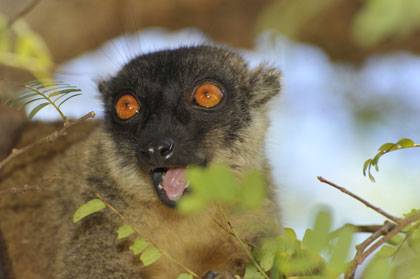
Anticipated climate changes in coming decades are likely to leave a lot of Madagascar's lemurs looking for new places to live. A new study predicts where the cat-like primates are likely to seek refuge if average temperatures throughout the island rise by 1.1 to 2.6 degrees by 2050, as predicted. Rainfall patterns are expected to change, too.Changes can already be felt. “Older people in Madagascar talk about how much drier and hotter it is now than when they were children,” said study co-author Anne Yoder, director of the Duke Lemur Center.Distant primate cousins to humans, lemurs evolved in Madagascar and are found nowhere else on Earth except in zoos and sanctuaries. Published in the journal Ecology and Evolution, the study includes maps showing where lemurs are likely to seek refuge as temperatures rise and rainfall patterns change across the 225,000-square-mile island over the next 65 years.The researchers predict that lemurs are likely to be on the move in search of new sources of the leaves and fruit they rely on for food. Fifty-seven of the roughly 100 known lemur species were included in the analysis.Some lemurs, like crowned sifakas, could fare relatively well. They and eight other species studied are predicted to benefit from changing climate by gaining an average of 80 percent additional territory. For a quarter of the species studied, ranges are predicted to stay the same size.But the majority of lemur species -- sixty percent -- could lose considerable amounts of suitable habitat before the end of the century due to climate change alone. Their habitats are predicted to shrink by hundreds of kilometers in some cases, and by nearly 70 percent on average.Hardest-hit would be species like the grey-headed lemur and the golden bamboo lemur, whose ranges are predicted to shrink to less than 1 percent of current sizes.Based on their projections, the researchers identified three previously overlooked areas on the island that will be particularly important for lemurs in the future. These include a mountainous rainforest region in northeastern Madagascar where the Duke Lemur Center has been sponsoring reforestation and other conservation initiatives since 2012.The researchers also pinpointed key forest corridors that would need protection if lemurs are to reach future habitats from their current spots.“The important corridors aren’t necessarily species-rich, or the only areas where some species are found," said co-author Jason Lee Brown of The City College of New York. "But they provide a key transition zone if lemurs are to get from the areas where they live right now to the areas that will be most suitable in the future.” The recommendations are all the more critical given that the models don’t take into account other threats to lemurs and the many animals that share their forest home, the researchers say.Every year, thousands of acres of Madagascar’s forests disappear due to illegal logging, mining and burning to clear space for crops. Such habitat losses will likely increase, as the country’s current population of about 22 million is projected to more than double by 2050.Most conservation planning in Madagascar prioritizes areas containing the highest species diversity or the greatest number of unique species, not habitats those species might move to in the future under climate change, said Brown, who was a postdoctoral researcher at Duke at the time of the study.“We’re trying to identify areas that might be neglected by current action plans but will be critically important for conservation planning in Madagascar going forward,” Yoder said.The research was funded by Duke University. The full journal article can be found here in DukeSpace, the open-access online repository of university research.